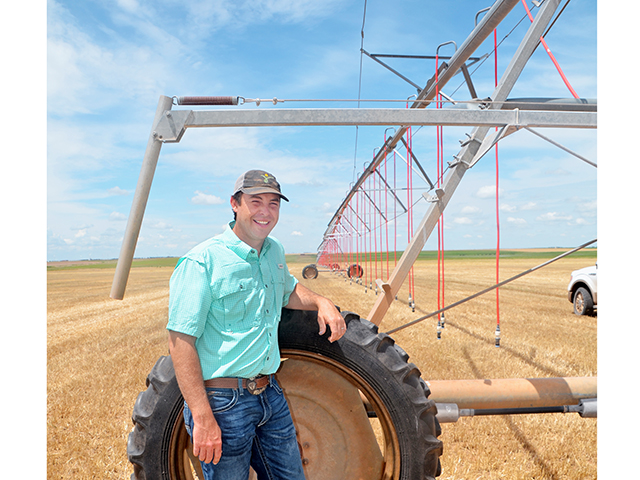Renovate Used Pivots for Savings
Make Used Pivots Pay
Managing 52 center-pivot sprinklers divided between two large Texas Panhandle farms 80 miles apart takes a sharp accounting pencil to keep the ledger sheet balanced toward the black.
Braden Gruhlkey and his brothers, Brittan and Cameron, are very cost-conscious on their home operation, near Wildorado, just west of Amarillo, where they produce corn, cotton, silage and seed milo. Likewise on a similar-sized 100%-irrigated corn and cotton operation they partner in the northwestern part of the Panhandle near Dalhart. That frugality is why, in addition to the sharp pencil, Braden says they've added a "pinging hammer" to their cost-cutting toolbox.
The hammer has become a diagnostic tool for determining the condition of irrigation pipe on used sprinklers the brothers seek out for their operation.
"If you're looking at used irrigation machines, you need to know the sound of a hammer on good, clean pipe," Braden explains. "Clean pipe will 'ping,' while corroded or rusted pipe will just make a 'thud' when you tap it. Knowing the difference can save you a lot of trouble and help you avoid sprinklers that are badly rusted and corroded from chemically active groundwater or hours of fertigation."
He says 10 of the 52 sprinklers he and his brothers oversee have been bought used or retrofitted from existing machines on their farms.
SAVE HALF
"Overall, if we do our job in selecting used machines correctly, we can save about 50% of the price of a new center-pivot sprinkler," he explains. "We've bought nearly a half-dozen used pivots since we began farming together as a partnership in 2008, and on a couple of them, we learned some hard lessons about pipe. Those machines have served us well, but we've had to work on them over the years because the pipe wasn't in top condition.
P[L1] D[0x0] M[300x250] OOP[F] ADUNIT[] T[]
"Now, we avoid looking for used machines in areas of salty or alkaline water, and do thorough 'ping' tests on any sprinkler we're considering retrofitting for our farm," Braden explains.
"Some people who only buy new machines think we're crazy, but we've had good luck with it. My brothers and I are still young and don't mind doing these projects. Also, our farm is diversified enough we have sufficient labor on the ground to help retrofit these machines through the winter.
"When I'm 55 I may look at all this differently," he says. "I hope I have the money to buy new then. Maybe, by what we're doing now, we will have the money later."
USED BUYING TIPS
Braden Gruhlkey says buying used pivots probably won't work for everyone, but for those who can make it pencil out in areas where good-quality used machines exist, he offers the following tips for identifying a good used sprinkler machine.
-- First, know a very inexpensive used center-pivot sprinkler will be shot, and if you're hiring all your work done, buying used won't pencil out. Be willing to and capable of doing your own work.
-- Crawl up on the machine and inspect the pipe. Look at the gooseneck. Is it damaged, rusted out or missing?
-- Know the sound of a hammer on good pipe. Hammer out likely spots where water collects in the spans, usually in dead spots that always remain wet.
-- Inspect the gearboxes. Check for oil leaks. On towable machines, realize they will have been moved many miles. So, if you buy a towable, consider a permanent installation for it, and pay close attention to the gearboxes.
-- Realize half-mile sprinklers must carry heavier weights of water and are subject to more mechanical stress where parts move. Look for cracks and signs of leaks in the pipe along with signs of shear bolt failure, etc.
-- Inspect the wiring for any signs of wear, breaks or arcing. While wiring problems are rare, span cable is expensive to replace, so an extra look is always worth it.
-- If a machine has been used in grazed fields, look for cattle damage.
-- Stick with machines no older than the mid-1990s.
[PF_0921]
(c) Copyright 2021 DTN, LLC. All rights reserved.




